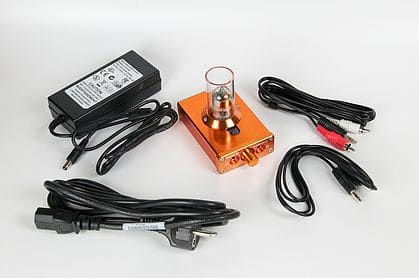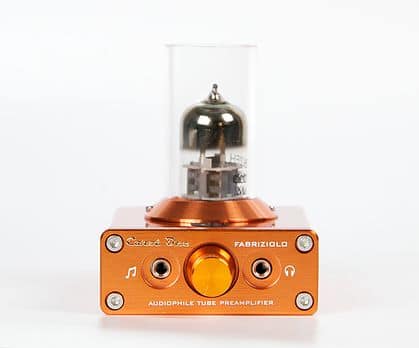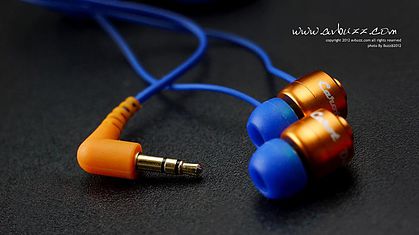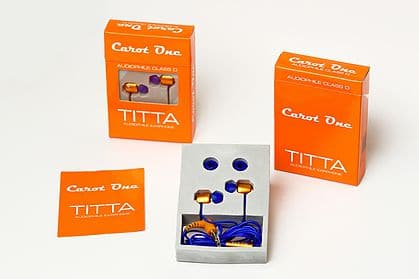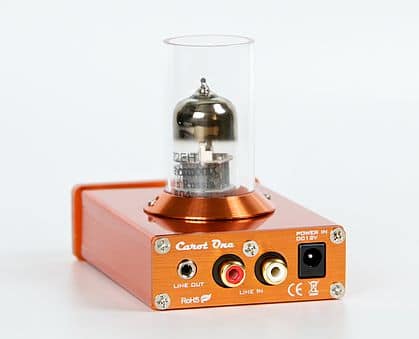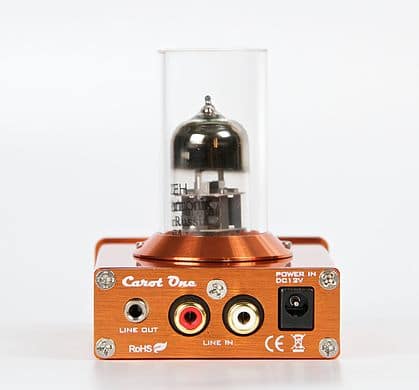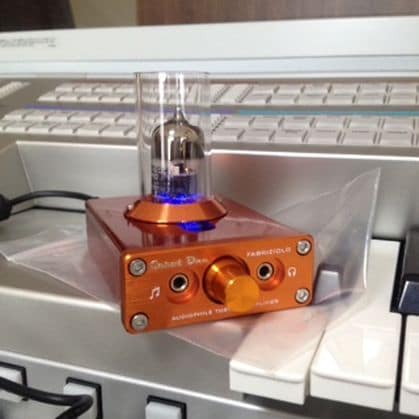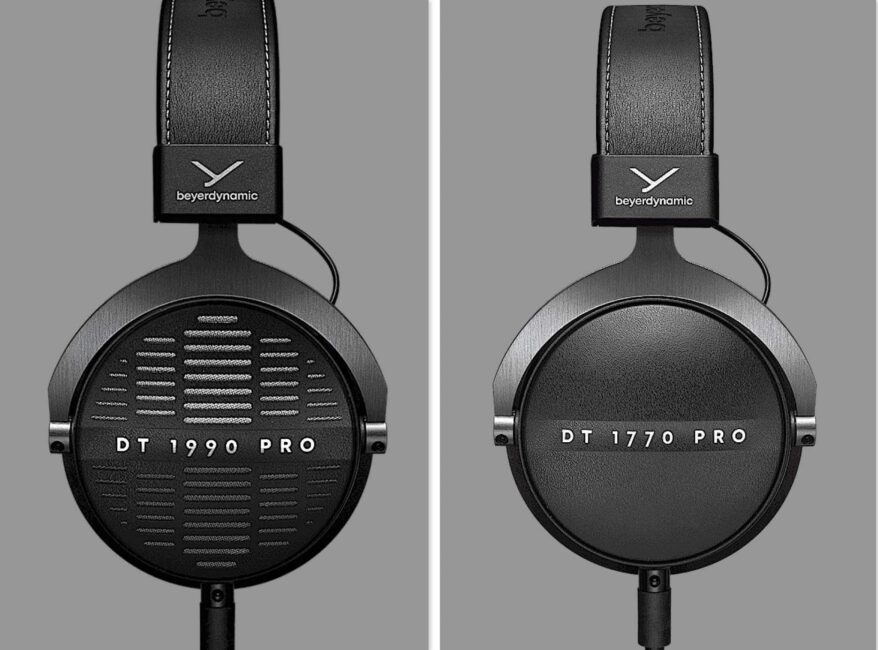The Article
Carot One Fabriziolo headphone amplifier and the Titta earphones
3rd October 2015
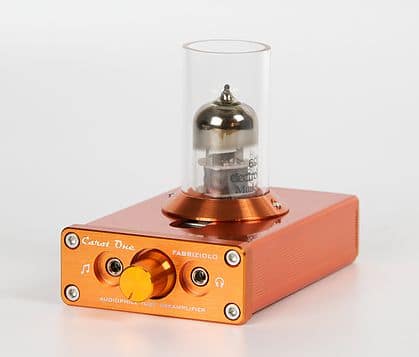
Looking for a small footprint headphone amplifier (and preamp) with matching earphones? Paul Rigby reviews one possible solution, the Carot One Fabriziolo headphone amplifier and the Titta earphones
The headphone sector is one of the few vibrant and cross-denominational genres of the Hi-Fi industry. Vibrant because, whenever you walk into a hi-fi show, at least in the UK, the section containing the headphone manufacturers is still bursting with energy, excitement, a cacophony of voices and hardware flying all over the place. The rest of show moves around at a far more sedate pace. Why cross-denominational? Because headphones are of interest to all sectors of the public and all ages. Headphones are a true lifestyle commodity which means that there are profits to be made. Hence, just about every hi-fi manufacturer out there is jumping on the headphone bandwagon.
Carot One, based in Italy, produces a rage of diminutive hardware, all presented in a stand-out, well, carrot colour I suppose. Burnt orange, if you want to be all interior designer about it. The company produces a range of DACs, pre-amps, phono amps and, reviewed here, a tiny headphone amp with accompanying earphones.
The headphone/preamp amplifier, known as the Fabriziolo, spans just 65x25x98mm and sports two frontal sockets. One for a pair of headphones and another for a music player of your choice. A centre-mounted combined rotary on/off and volume knob completes the frontal array. On the rear, you will find a pair of RCA connections to plug directly into an amplifier or pre-amp plus a line-out jack to access a pair of powered speakers, for example.
Star of the show is the vertically mounted, Russian-built, 50s-era, 6922 valve. Although you can use a 12AU7, if you wish. I was supplied with the 6922 (electrically identical to the E88CC), a dual triode and one known for its long life.
This 3W amplifier is powered by an external brick power supply. One end of the brick connects to the Fabriziolo via a standard 5.5mm connection, the other end offers an IEC connector to the mains, which allows a cable upgrade, if you wish.
Moving to the Titta earphones (an unfortunate choice of name that will, if nothing else, be a memorable one), it is bedecked in the same burnt orange (ear pieces) and blue (lead) finish. The Titta earphones arrive in a die-cast aluminium chassis featuring 11mm drivers with a 16 Ohm impedance and a 1.2m cable.
IN USE
Set up of the Fabriziolo is quick and painless. As long as you are careful in locating the valve pins, you will be up and running in a few minutes. Once you turn on the unit you will notice a blue LED that shines up through the valve, offering a static light show. I have to say, though, that the overall blue/orange effect looks a little tacky. A bit too bling-y for me. Another issue with the Fabriziolo is the build quality. It not only feels rather fragile but I question the internal manufacturing. Donning my reference Sennheiser HD650 headphones, just touching the power lead triggered a nasty hum.
For the Titta, the lead noticeably bucked and weaved all over the place, like an angry snake and was, it has to be said, a pain in the neck to handle. A single extra pair of rubber ear plugs were available in the windowed, cigarette packet-like, container.
During the sound quality tests, apart from the similarly priced Epiphany OHP-02Di’s headphone amplifier, I also decided to compare it to ALO’s similarly diminutive Pan Am headphone amplifier. Yes, the Pan Am is more expensive than the Fabriziolo (at around twice the price) but, taking the sonic differences into account, I wanted to see how the Fabriziolo coped. I expected the latter to make a brave fist of it and hoped that the Fabriziolo would provide a viable budget option for those who wanted but could not afford a piece of hardware of the class and quality of the Pan Am.
For the test, I stuck with the RCA inputs. I connected those to my reference pre-amp to enable me to play a vinyl source from my Avid Acutus turntable. I wanted to give the Fabriziolo as much chance as possible to show me what it could do.
SOUND QUALITY
Beginning with the Fabriziolo and a slice of prog from Yes’ The Yes Album and the track, Yours Is No Disgrace, the Fabriziolo, while not quite as broad in nature as the Epiphany, did fill the sound stage, providing a musical and enjoyable presentation. Although lacking the air and space to really allow the organ to soar or the guitar to paint complex patterns, the Fabriziolo did cover all bases, sonically, providing crisp upper mids.
Bass was well formed and tuneful. Despite not being big or bold, the lower frequencies on the Fabriziolo did form a firm foundation that drove the music forwards.
This prog track is packed with detail. There is something going on all of the time, especially when Steve Howe’s guitar is full flow. Although I wouldn’t called the Fabriziolo incisive, the Fabriziolo did reveal enough detail from the Howe guitar to keep your attention fixed on the progress of the music. The guitar was definitely light and melodic in tone, although not as tonal complex.
Similarly, although the bass guitar didn’t have any real guts, the Fabriziolo was able to follow the bass guitar easily and without any effort at all.
Once the vocals were in full flow, that harmonies were impressive on the Fabriziolo. Even though the detail wasn’t epecially discernible, yet the Fabriziolo did display recognisable layering in the arrangement.
Moving to classical music and Holst’s The Planets. Playing Mars – The Bringer Of War, one of the scariest and most threatening of classical tracks, it has a grandeur all of its own, the Fabriziolo did struggle to manage the magnificent and epic sound stage that the Pan Am, for one, created. The Fabriziolo’s sound stage was small in scale and stature while the rather compact suite of upper mids somewhat diminished the overall presentation. That said, the brass elements of the track were well presented, being very clean in nature with no obvious blooming. The crisp nature of the midrange was one of the highlights of the Fabriziolo’s overall performance, in fact.
Bass, though, was comparatively minimal which, again, reduced the impact of the track. Lower frequencies were restricted to upper bass and lower midrange elements that did provide useful musical cues, however.
Turning to the earphones, I compared the miniature Tittas with my similarly priced, reference, Sennheiser CD95 earphones. The Tittas were a pleasant surprise. They didn’t look particularly impressive from the off, the ear driver chassis looked rather cheap and nasty yet, during play, the earphones constructed a large and open soundstage that did justice to the grand music. OK, the bass was largely non-existent and the mids had no sense of fullness or complexity but the instrumental separation was excellent, taking full advantage of the large sound stage while the upper mids were quite detailed for the price. An admirable design for the price.
CONCLUSION
The Titta provides a decent standard of playback. It has its issues in terms of construction but, for the money, offers plenty of sonic highlights to provide an entertaining listen.
The Fabriziolo is a funky piece of kit. Arriving in a jazzy livery with a featured light show around the installed valve, it is rather let down by its build quality. Considering the relatively high price of the unit, this aspect is a disappointment. That said, the small stature of the chassis means that it is mobile and useful for audio fans short on space. The Fabriziolo provides a musical output that, while not excelling in any one area of the sonic spectrum, does provide a decent standard of sound quality and would be listenable as part of a second hi-fi system for a bedroom or study.
CAROT ONE TITTA
Price: €49 (P&P is free)
Website: www.carotone.it
Tel: +39 081 667086
GOOD: spacious soundstage, instrumental seperation, open midrange
BAD: unruly lead, design, bass
RATING: 6
CAROT ONE FABRIZIOLO
Price: €199 (P&P is free)
Website: www.carotone.it
Tel: +39 081 667086
GOOD: musicality, compact, generally crisp and clean midrange
BAD: build quality, price, finish, no sonic highlights
RATING: 5
REFERENCE SYSTEM
Avid Acutus Turntable
SME IV arm
Benz Glider cartridge
Aesthetix Calypso Pre
Sennheiser HD650 headphones
ALO Pan Am headphone amplifier
Epiphany OHP-02Di headphone amplifier/DAC
Chord C-line cables

